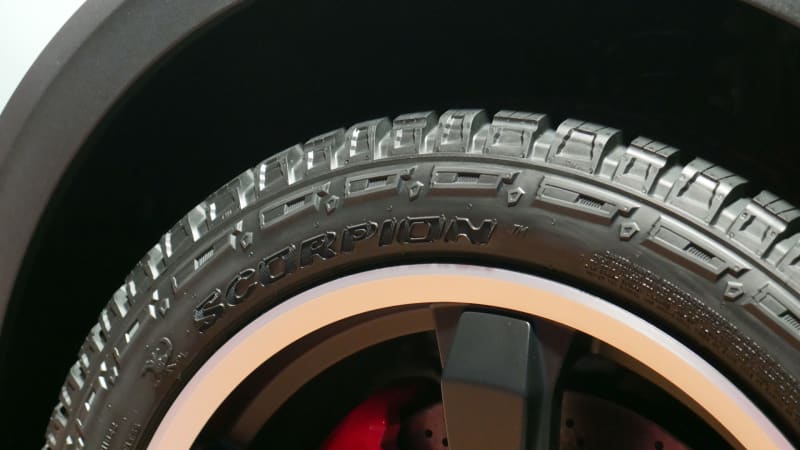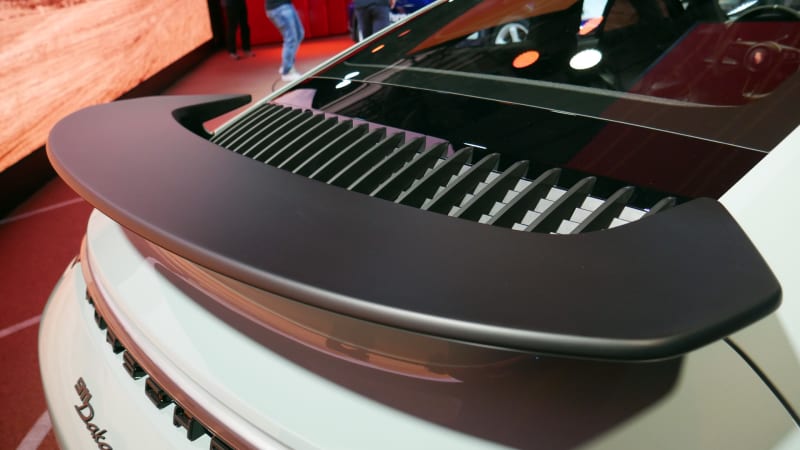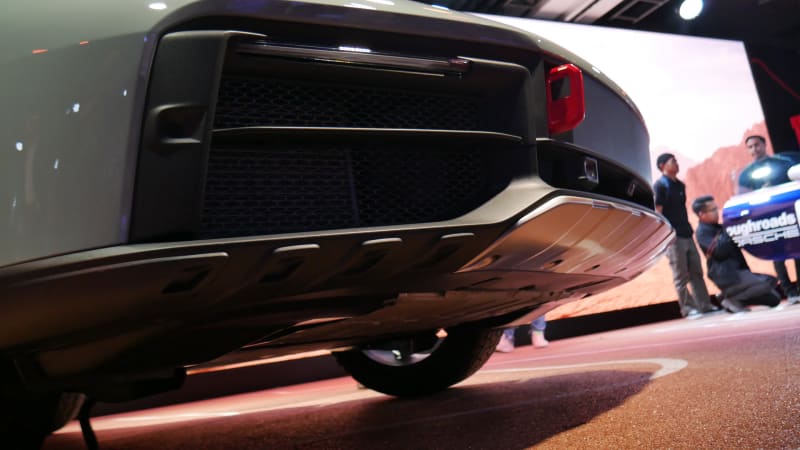2023 Porsche 911 Dakar First Look: Wildly different 911 might be the coolest one yet

LOS ANGELES — If you follow enough automotive-themed Instagram feeds, there’s a very good chance you’ve come across a 911 Safari. They are delightfully incongruous verging on the oxymoronic: one of the world’s most capable and famous sports cars jacked up, fitted with off-road tires, extra driving lights and a large roof rack probably holding a tire. Possibly a roof tent. Believe us, it’s a whole thing and it goes back decades with a rich rally history.
And now it’s an official factory thing thanks the 2023 Porsche 911 Dakar. Yes, this is a real car that Porsche will produce 2,500 units globally of starting next spring, joining the ever-expanding pantheon of 911 models. As much as a 911 GT3 painted eye-searing blue sticks out in a crowd, we’re guessing the new 911 Dakar might trump them all when it comes to attracting eyeballs.
It all starts with that height. It rides 50 mm taller than a 911 Carrera or nearly 2 inches thanks to stretched springs, dampers and suspension links (the track is wider, too). The standard hydraulic, height-adjustable suspension basically takes the front-axle lift system available on other 911s and doubles up with a second pump at the rear. It can raise the Dakar another 30 mm for a grand-total lift of 3.15 inches to 7.5 inches (the car is set to this “High Level” in the above photos). Both that figure and the ramp-over angle are comparable to a typical crossover SUV, and actually quite a bit higher than off-roadish wagons like the Audi A6 Allroad and Mercedes-Benz E-Class All-Terrain. And unlike that pair, plus most other vehicles with high-mode off-road suspension settings that automatically lower around 20 mph, the Dakar’s High Level can be used up to 105 mph “for spirited off-road driving.” Or just looking bomb in Santa Monica.
Stuffed in those flared fender arches are specially designed Pirelli Scorpion All Terrain Plus Tires measuring 245/45 ZR 19 at the front and 295/40 ZR 20 at the rear. They have 9 mm of tread depth plus reinforced sidewall with two carcass layers for damage resilience. Summer and snow Pirelli P Zero tires are optional and also feature the reinforced layers.
All-wheel drive is not surprisingly standard and is enhanced with modified diffs and a pair of Dakar-specific driving modes intended for the off-road arenas in which this 911 is intended to excel: sand and loose gravel. Rallye Mode biases power to the rear axle for loose and uneven surfaces and sure sounds like the makings of one helluva good time. Off-Road Mode maximizes traction in sand and rougher terrain, and automatically engages suspension’s High Level. There’s also a Rallye Launch Control that can be used with either off-road mode specifically engineered to operate on loose surfaces. I think that calls for a “yee-haw!”

Power comes from the GTS, or three rungs up the 911 model ladder. Its 3.0-liter twin-turbo boxer-six engine produces 473 horsepower and 420 pound-feet of torque, and with its obligatory eight-speed PDK automated manual transmission, can hit 60 mph in 3.2 seconds. Top speed is limited to 150 mph due to those all-terrain Pirellis. Oh darn.
Now, for those keeping track at home, that 3.2-second 0-60 time is only 0.1-second slower than an all-wheel-drive 911 Carrera 4 GTS despite the height-adjustable suspension, giant tires and other tacked-on bits. The reason: Its curb weight of 3,552 pounds is only 16 pounds more. Weight was cut by utilizing the GT3’s carbon-fiber-reinforced-plastic (CFRP) hood and lightweight glass used in various places throughout the 911 lineup, including the 911 Carrera T that you can read about next week here on Autoblog. Other weight-saving items can be found inside where Porsche’s carbon fiber fixed-rake Full Bucket seats are standard (18-way power-adjustable ones are thankfully optional) along with an obligatory back seat delete. Besides the weight savings, removing the back seat was necessary to fit the added rear axle hydraulic pump.
The Dakar also picks up from the 911 parts rack engine mounts from the GT3, the Porsche Dynamic Chassis Control system that mitigates body roll (probably a good idea for a 911 with 7.5 inches of ground clearance) and standard rear-axle steering that was modified for the all-terrain tires. The spring rates are of course different and the dampers more robust, while the brakes are from the Carrera S, since the larger brakes on the GTS aren’t really needed given the Dakar’s lower maximum speed. They’re also lighter. The cooling system from the 911 Turbo S was used since the design of its center intercooler is less likely to be damaged off-road than the one found in other 911s.
Despite the off-road intentions, the 911 Dakar’s on-road capability surprised even Porsche’s engineers. For instance, the reinforced Pirellis were originally developed as summer tires, but when the all-terrains proved to do so well in terms of on-road grip and noise, they were made standard equipment. Also, Porsche says that the Dakar’s lap time around the Nürburgring Nordschleife is the same as the 996-generation GT3 from 20 years ago. Not bad.


Visually, the 911 Dakar gets a fixed rear spoiler, red forged aluminum tow hooks and those exaggerated fender arches and rocker panels, plus various stainless steel body elements. Among those are stainless steel mesh grilles and underbody guards in the nose, which was shortened for improved approach angles. Up top, an optional roof basket can hold as much as 92 pounds of equipment and can be fitted with headlights running off a standard 12-volt socket located within the shark fin antenna housing. A roof tent is also available, though the 911 Carrera has long been able to accommodate one of those thanks to strong mounting points in the roof.
Besides the standard fixed buckets and no back seat, the interior gets standard Race-Tex upholstery with Shade Green stitching. The car pictured above wears the matching exterior paint color that’s exclusive to the Dakar.
And should driving around in a factory-fresh off-roading 911 not be bold enough, the Rallye Design package gets you a full-fledged homage to the 911 that won the 1984 Paris-to-Dakar rally (hence the name, by the way). You get a combination of white and Gentian Blue metallic paint with gold and red stripes, and both the wheels and wing painted white. Mind you, that Dakar-winning car wore Rothman’s advertisements, which is not only no longer a Porsche sponsor and a separate company, but one that sells cigarettes. Not exactly kosher in 2022. “Roughroads” is therefore put in its place alongside door-mounted numbers of the customers’ choice between 1 and 999. And no, getting 69 would not be funny, Todd.
Pricing starts at $223,450, including destination, but come on, that’s just the subterranean floor upon which dealers will stack their market adjustments. For reference, a Carrera 4 GTS starts at $151,350, and only the 911 Turbo S Cabriolet, 911 GT3 RS and 911 Sport Classic are more expensive. Of course, you have to ask yourself how much one of those aftermarket outfits would charge to transform a Carrera 4 GTS into a safari 911? OK, so even if the answer is “nowhere close to that,” the 911 Dakar is still tremendously cool. With the Lamborghini Huracan Sterrato on its way, a charmingly nutty automotive niche is starting to get carved out. We cannot wait to drive this.



